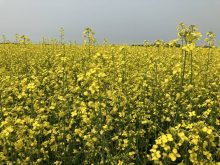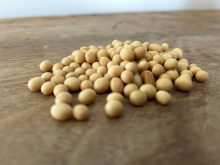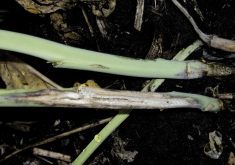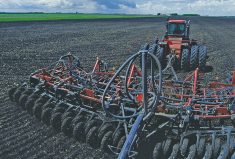Glacier FarmMedia – Winter isn’t exactly prime time to scout for insects, diseases and weeds, but last year’s pests may provide a baseline to help prepare for the next canola crop, agronomists say.
“Review the challenges you had last year and have a plan in place as to how you’re going to handle them this year,” said Warren Ward, agronomy specialist with the Canola Council of Canada.
“Maybe look back over a couple of years and see the challenges you dealt with on the farm and what you can do to make sure that they’re not going to be yield limiting in 2024.”
Read Also

Hail research hopes to benefit potato growers
Alberta research scientist measures hail storm and heat dome affects on potato crops
Issues like blackleg or herbicide-resistant weeds can be anticipated from last year’s field, but crop pests might be different year to year.
Trevor Herzog, Western Canada agronomy lead with Corteva Agriscience, said growers should be ready if it looks like another dry spring is in the works.
“Keep an eye on forecasts and weather. … If the forecast does look dry, then a farmer may decide to start seeding a little sooner just to try to take advantage of the existing moisture before it blows away in the wind or starts to disappear from that ideal seeding depth for the crop they’re considering.”
Herzog also reminded farmers to have seed treatment and weed control plans in place. In particular, he noted seed treatments that target flea beetles, cutworms and seedling blackleg.
“If you have patches of weeds that seem to get an early start and they are taking advantage of the early season moisture, make sure you have a weed control plan figured out to take away that early season pressure on the crop that’s trying to grow through a stressful environment,” he added.
After applying a tank mix with glyphosate, producers should “monitor those weeds as they get the odd shower here or there. And then maybe [apply] an early season in-crop application of some herbicides to keep the weeds at bay and allow that crop to get established.”

Flea beetles and grasshoppers
Although flea beetles have become a commonly cursed scourge of canola in the early growing season, 2023 was not the worst beetle pressure Western Canada has seen. Last year was relatively quiet on the insect pest front from a Prairie-wide perspective, said Ward.
That doesn’t mean this year will be the same.
“Even if you had a good year with [flea beetles] last year, don’t be lulled into a false sense of security.”
The same goes for grasshoppers.
“If it remains dry in the spring, that will be something to watch out for into the new year,” Ward said.
Other insect pests
Aside from localized populations in Alberta, diamondback moths were not out in force in 2023, said Ward, though the Manitoba pest report noted spraying in all regions except the southwest and counts up to 60 per square foot.
Looking to 2024, the moth is always a pest species to look out for, Ward said.
“They come up with the wind currents from the United States. Keep an eye on the monitoring maps and the traps that are out there to predict where and when they might become an issue.”
Alfalfa looper was another pest reported in parts of the Prairies.
Loopers were not a species of note in the season’s pest summary, although Ward noted the green caterpillar confounded other western Canadian producers and agronomists.
“It looks a little bit like bertha armyworm but greener,” he said, noting alfalfa loopers appear earlier.
Ward urged producers to brush up on pest identification knowledge so they manage the right problem when it appears.
“In some cases, [species] may look similar but don’t do similar damage or, in some cases, they do similar damage. So, it’s a matter of knowing what you’re dealing with and that’ll give you the options that are available.”
The disease usuals
Verticillium stripe is under the microscope of agronomists and researchers, and is specifically a disease of note in the eastern Priries.
The pathogen was the second-biggest threat identified by Manitoba Agriculture’s 2023 Canola Disease Survey in terms of prevalence. One in every four surveyed fields was infected. Blackleg was found in 86 per cent of fields.
While Manitoba is the Prairie hotbed for verticillium stripe, Ward said symptoms have been found in eastern and central Saskatchewan as well, and it’s not likely to stop there, as it moves westward.
There are few management strategies, but there’s at least one identified condition that seems to exacerbate the issue.
“Dry, stressed conditions later on in the growing season is where it seems to show up worse,” said Ward.
“You can’t really scout for it until later in the season. Even at swathing time, it’s tough to distinguish. The best time to scout for it is after harvest when you can go out there and identify it on stubble.”
Much of the Prairies saw a season of low sclerotinia pressure, but Ward urged producers to remember that good growing conditions for canola are often friendly to sclerotinia.
“Looking at what conditions are during the growing season is really going to be the number one factor as to whether we see that disease developing next year.”
Producers should be “thinking about it and going through the risk assessment for sclerotinia as we get into that flowering time of year,” he added.
If there was blackleg in the field in 2023, assume it will also be there this year and plan accordingly, said Ward.
“If you know you had higher blackleg levels last year, especially if you sent some samples away for race identification to a lab, you’ve got some more information where you can start looking at finding a variety that is resistant to that race.”
Aster yellows
Last year was also the worst year since 2012 for aster yellows on the Prairies, particularly in areas of western Saskatchewan and into Alberta, said Ward.
The 2023 Canola Disease Survey found aster yellows symptoms in 20 per cent of the 100 fields monitored. Between 2018 and 2022, the survey found prevalence of the disease at 10 per cent or below.
Crop pathologists also noted the surge in aster leafhoppers observed earlier in the season. A vector for aster yellows, the insects tipped surveyors that 2023 might be a bad aster yellows year.
There aren’t many control options for aster yellows, Ward noted. The best producers can do is watch for reports of aster leafhoppers moving in from the U.S.
“It’s not something you can really plan around [aside from] looking for it. The chances of it being really bad two years in a row are low but not inconceivable.”
Weeds
Winter is also a good time for growers to assess options for herbicide-resistant weed management, Ward said.
“If you know you have resistance on your farm, look at planning right now what you can do. A herbicide system would be one [strategy]. Give yourself the most options to be able to deal with those weeds.”
Resources
In-depth information on insects, diseases and weeds common in canola, including management strategies, is available on the Canola Council of Canada website. Information on a number of crop pests is also available on the Prairie Pest Monitoring Network website.
















